
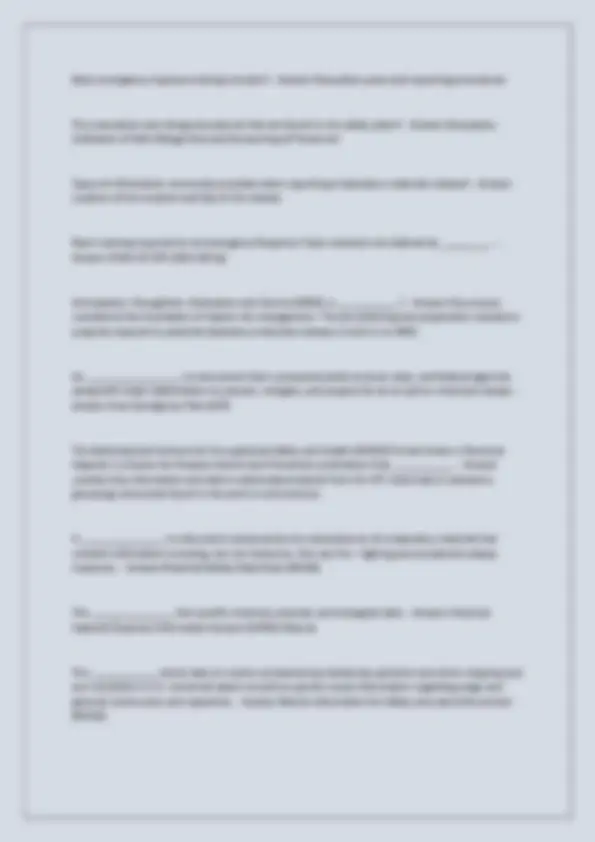

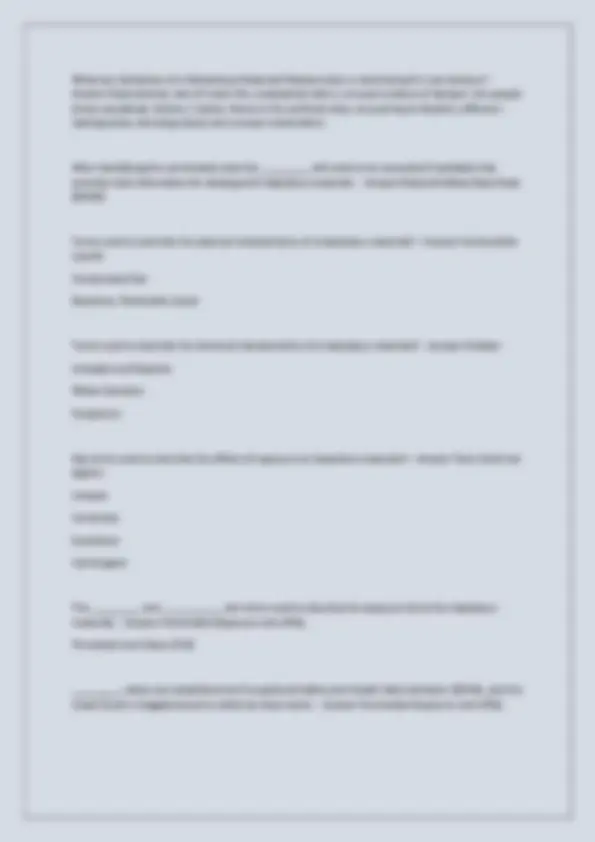


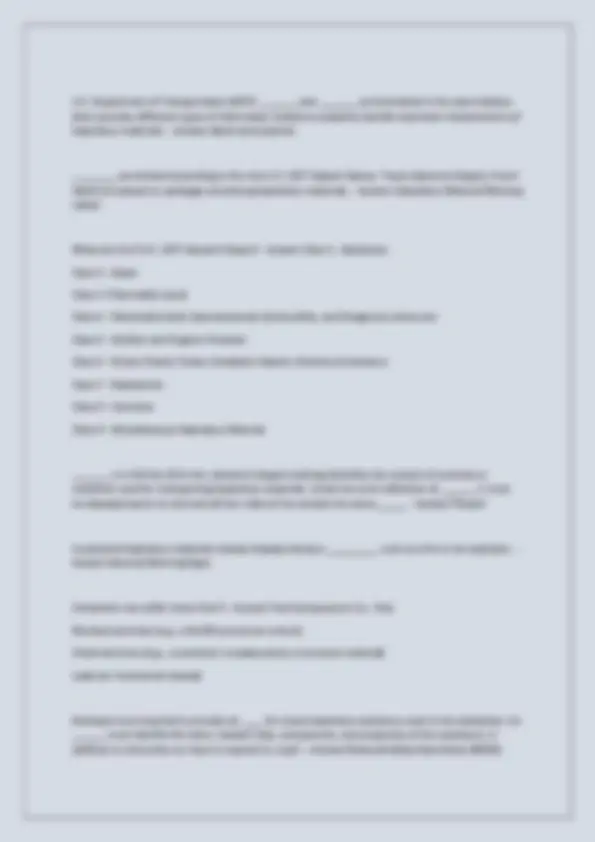

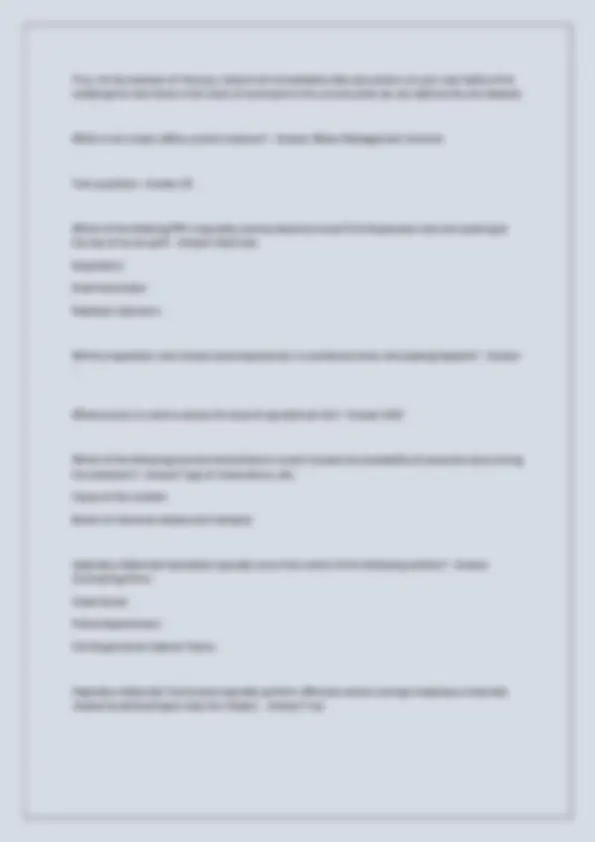
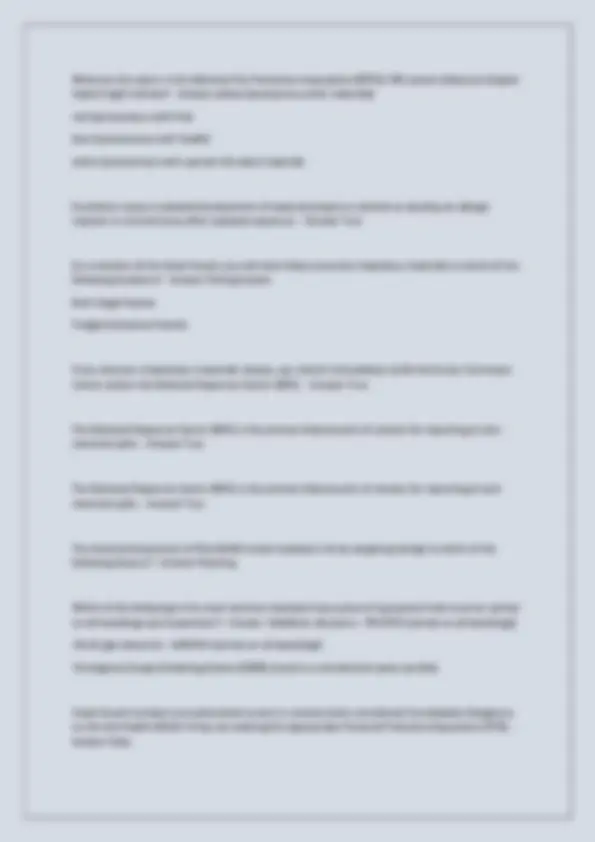






Study with the several resources on Docsity

Earn points by helping other students or get them with a premium plan


Prepare for your exams
Study with the several resources on Docsity

Earn points to download
Earn points by helping other students or get them with a premium plan
Community
Ask the community for help and clear up your study doubts
Discover the best universities in your country according to Docsity users
Free resources
Download our free guides on studying techniques, anxiety management strategies, and thesis advice from Docsity tutors
An overview of the key standards, regulations, and procedures that first responders and coast guard personnel must be familiar with when dealing with hazardous materials incidents. It covers topics such as the superfund law, the hazard communication (hazcom) program, emergency response training, hazardous material characteristics, container types, and the anticipation, recognition, evaluation, and control (arec) process used in operational risk management (orm). The document also includes a glossary of relevant acronyms and terms related to hazardous materials response. This information is crucial for ensuring the safety of personnel, the public, and the environment when responding to hazardous materials releases or spills.
Typology: Exams
1 / 21

This page cannot be seen from the preview
Don't miss anything!














CAMEO Chemicals - Answer http://cameochemicals.noaa.gov/browse Which laws and regulations should First Responders become familar with then questions arise? - Answer RCRA, CERCLA, SARA, HAZCOM, OPA 90 and HAZWOPER contain in the field standards used by First Responders when working in hazardous sites. What is the Resource Conservation and Recovery Act (RCRA)? - Answer Resource Conservation and Recovery Act (RCRA) required the Environmental Protection Agency (EPA) to begin cradle-to-grave tracking or hazardous waste and required the establishment of standards for hazardous waste treatment, storage, and disposal facilities. What is the Comprehensive Environmental Response Compensation Liability Act (CERCLA)? - Answer The Superfund law provides funds to the Coast Guard (through EPA) for emergency response containment and cleanup of abandoned hazardous material releases. What are the tasks that emergency responders are trained to perform? - Answer Awarness Level Operations Level Technician Specialist Incident Commander Items that are documented in a Contingency Plan that directs First responders on what to do? - Answer Emergency Notifications Emergency Response Procedures Command Structure Identification of Resources
Scenerios What is the Superfund Amendments and Reauthorization Act (SARA)? - Answer An extension and expansion of CERCLA required the EPA to issue regulations mandating compliance with the OSHA HAZWOPER regulation in all area no under OSHA juridicion. SARA specifically required the EPA to revise how it determines the risk posed to the public and evironment by uncontrolled hazardous waste sites. It also included a provision referred to as Community Right to Know which requires all businessess to provide the government with detailed information about the hazardous materials they work ith and have on site. What is the Hazard Communication Right to Know (HAZCOM)? - Answer HAZCOM serves as the foundation for unit's Hazard Communication Program. HAZCOM specifically requires employers to inform their employees about any hazardous materials they might encounter on the job and to provide them with the resouces needed to handle them appropriately. What is the OPA 90? - Answer Specifies the following:
_______ are documents that are prepared by facility managers to prevent, mitigate, and prepare for a chemical release which are not limited to evecuation routes, decontamination procedures, and notification procedures. - Answer Facility plans ________ and equipment are used for mission parameters to protect personnel and public safety. - Answer Personal Protective Equipment (PPE) What are the 7 pre-panning essential elements for managing an emergency effectively? - Answer Personnel (Always Ready), Equipment, Training, Communications, Environment, Unknown Varables (Limit), Planned Evacuation Routes. Air monitoring items used during field activities and emergency response? - Answer Multi-Gas Detector (e.g., GAMIC - 4), Radiation Detector (e.g., PM3702 Pager), Emergency Escape Breathing Device (EEBD). What are Risk Assessment Models used during an emergency response? - Answer Severity, Probability, Exposure (SPE) Model and the Green, Amber Red (GAR) Model What is the purpose of anticipation / pre-mission planning? - Answer To protect personnel, the environment, and the public's health and safety. What is the resource used during the pre-planning process of an emergency? - Answer Chemical, Hazard, Response Information System (CHRIS) Manual What is the evironmental factors that could increase the probability of personal injury during an evoulution? - Answer Types of chemicals on site, Cause of the incident, and extent of chemical release and support What are the preparation and mission planning element considered when anticipating hazards? - Answer Personnel, Cause of the Incident, Extent of Chemical release and transport. What equipment can help protect against chemical and physical hazards? - Answer Emergency Escape Breathing Device (EEBD), Multi-Gas detector and Radiation detector What is the acronym for SPE stand for? - Answer Severity, probabiltity, expose
What are indications of a Harzardous Materials Release when a chemical spill is not obvious? - Answer Dead animals, lack of insect life, unexplained odors, unusual numbers of dying or sick people (mass casualties), blisters / rashes, illness in the confined area, unusual liquid droplets, different - looking areas, low-lying clouds and unusaul metal debris. After identifying the conminated area the _________ will need to be consulted if available that provides vital information for dealing with hazardous materials. - Answer Material Safety Data Sheet (MSDS) Terms used to describe the physical characteristics of a hazardous materials? - Answer Combustible Liquids Compressed Gas Explosive, Flammable Liquid Terms used to describe the chemical characteristics of a hazardous materials? - Answer Oxidizer Unstable and Reactive Water-Sensitive Pyrophoric Key terms used to describe the effects of exposure to hazardous materials? - Answer Toxic Chemical Agents Irritants Corrosives Sensitizers Carcinogens The _________ and ___________ are terms used to describe the exposure limits for hazardous materials. - Answer Permissible Exposure Limit (PEL) Threshold Limit Value (TLV) _________ values are established by Occupational Safety and Health Administration (OSHA), and the Coast Guard is leagally bound to abide by these levels. - Answer Permissible Exposure Limit (PEL)
If a gas has a vapor density of less then _______ the vaport will generally rise in the air. If the vapor has greater then _______, the gas will generally sink in the air. - Answer one _________ tells you whether a liquid will rise or sink when it is put in water. - Answer Specific Gravity ________ has a specific gravity of 1.0. Anything greater then 1.0 will sink and anything less then 1. will rise. - Answer Water Terms used to describe firefighting considerations - Answer Flash Point Flammable or Explosive Limits A liquid's _________ is the lowest temperature at which it gives off enough vapor near its surface to form an ignitable mixture with air. - Answer Flash Point __________ with low flash points are more combustible that _______ with high flash points. - Answer Liquids Liquids are classified by their flash points as either combustible or flammable. However the _______ and ________ have different standards for combustible and flammable liquids. - Answer National Fire Protection Agency (NFPA) Department of Transportation (DOT) Flammable and Combusitble limits as described by the National Fire Protection Agency (NFPA) - Answer Flammable - Less then 100 degrees farenheit Combustible - Greater than 100 degrees farenheit Flammable and Combusitble limits as described by the Department of Transportation (DOT) - Answer Flammable - Less then 141 degrees farenheit Combustible - Greater than 141 degrees farenheit and below 200 degrees farenheit The Flammable or Explosive Limits section of the ________ provides a concentration range within which vapors produced by a liquid if exposed to an ignition source. - Answer Material Safety Data Sheet (MSDS)
Concentration limits of vapors - Answer Lower Limit - lowest concentration of vapor that will ignite Upper Limit - highest concentration of vapor that will ignite If Iso-Butane has a lower explosive limit of 1.8 percent and an upper limit of 8.44 percent. If you enter a room with a 6 percent concentration of Iso-Butane and light a match, will the vapor ignite? - Answer Yes Toluene has a specific gravity of 0.86. If it was spilled in a river, what would the subtance do? - Answer Float on top of the water as toluene is less dense than water so it would float. What is an indication of a hazardous materials has been released in an area. - Answer Dead animals, illness to a confined area, low - lying clouds What is the definition of a combustible liquid limit - Answer Greater then 100 degrees farenheit and Greater than 141 degrees farenheit and below 200 degrees farenheit What is a mystery liquid with vapors that tend to stay close to the ground. - Answer Hydrochloric acid - 1.2, because any liquid with a vapor density greater than 1 will tend to stay close to the ground. What is the the color coded manual assists with hazardous material release? - Answer Emergency Response Guidebook (ERG) The Emergency Response Guidebook (ERG) provides the following - Answer Lists U.S. Department of Transportation (DOT) Hazard Classes, Materials listed numerically by ID number (yellow pages), materials listed by alphabetically by name (blue pages), safety recommendations and emergency response info (orange pages) and Isolation and protection distances for material releases _________ is a mnemonic that can help you remember the points you must consider when attempting to recognize a hazardous materials release. - Answer COMPASS COMPASS abbreviation - Answer C- Container O - Occupancy / Location M - Markings / Colors P - Placards / Labels
U.S. Department of Transportation (DOT) _______ and _______ are formatted in the same fashion. Each provides diffenent types of informaton needed to properly identify important characteristics of hazardous materials. - Answer labels and placards ________ are divided according to the nine U.S. DOT Hazard Classes. These diamond-shaped, 4 by 4 labels are placed on packages containing hazardous materials. - Answer Hazardous Material Warning Labels What are the 9 U.S. DOT Harzard Classes? - Answer Class 1 - Explosives Class 2 - Gases Class 3- Flammable Liquid Class 4 - Flammable Solid, Spontanelously Combustible, and Dangerous when wet Class 5 - Oxidizer and Organic Peroxide Class 6 - Poison (Toxic), Poison Inhalation Hazard, Infectious Substance Class 7 - Radioactive Class 8 - Corrosive Class 9 - Miscellaneous Hazardous Material _______ is a 10.8 by 10.8 inch, diamond shaped marking identifies the contest of a vehicle or container used for transporting hazardous materials. Under the strict definition of ______, it must be displayed point on end and all four sides of the contain the same _____. - Answer Placard A potential hazardous materials release displays obvious _________, such as a fire or an explosion. - Answer External Warning Signs Containers can suffer stress from? - Answer Thermal exposure (i.e., fire) Mechanical stress (e.g., a forklift punctures a drum) Chemical stress (e.g., a container is weakened by a corrosive material) Leaks (or intentional release) Employers are required to provide an ____ for every hazardous substance used in the workplace. An ______ must identify the name, harzard class, components, and properties of the substance, in addition to instruction on how to respond to a spill. - Answer Material Safety Data Sheet (MSDS)
______ is considered the last line of defense when trying to recognize a harzardous materials release because it is the most dangerous. - Answer A person five senses ________ is a mnemonic for hazardous materials recognition. It stands for container, Occupancy / Location, Markings / Colors, Placards / Labels, Appearance, Shipping Papers / MSDS, and Senses. - Answer COMPASS The external warning signs of a possible hazardous materials realease that can be identified when examining containers - Answer Thermal exposure Mechanical Stress Leaks As a member of the Coast Guard, you will most likely encounter hazardous materials in the following locations? - Answer Fishing Vessels Fish Processing Vessels Freight / Container Vessels _________ are typically used to transport corrosive materials in bulk - Answer Ribbed tank cars Considering the various gases that may be present during a tank vessel casualty, what may present the greatest hazard to responders due to its tendency to congregrate in low lying areas? - Answer Benzene 2. Always use the information provided on _______, ______ and _______ to identify hazardous materials. - Answer markings, placards, and labels _________ is a seven - step job aid that systematically evalutes hazards identified with a specific task or operation. - Answer Operational Risk Management (ORM) The first steps in the Operational Risk Management (ORM), a Coast Guard Policy are directly related to the _____ process. - Answer Anticipation, Recognition, Evaluation, and Control (AREC) process. What are the 7 steps of Operational Risk Management (ORM) - Answer Identify Mission Tasks
The 3 main categories of controls implemented during the control phase of the Anticipation, Recognition, Evaluation, and Control (AREC) process? - Answer Engineering Controls (e.g., ventilation & machinery guards, etc are removed) Administrative Controls (e.g., training, monitoring & tracking) Personal Protective Equipment (PPE) The steps involved in ______________ in Operational Risk Management (ORM) are part of the Anticipation, Recognition, Evaluation, and Control (AREC) processes and provide important informaton to guide your continued maintenance of the Risk Management Process. - Answer Risk verses Gain The ________ in Operational Risk Management (ORM) is used to calculate the degree of risk given the controls identified during the control phase of the Anticipation, Recognition, Evaluation, and Control (AREC) process. - Answer Risk verses Gain After the risks have been identified and assessed, and the control decisions have been made in the Operational Risk Management (ORM) process, it is time to implement the controls and ________. - Answer Execute the decisions The final step in the Operational Risk Management (ORM) process is _______ as efforts progress to clean up the hazardous materials. - Answer Monitor the Situation If a change in the situation is identified or if a presumed condition does not exist, the Operational Risk Management (ORM) process needs to be _____ to take the change into account. - Answer repeated entirely Which process is used to asses the level of risk of identified hazards? - Answer SPE and GAR are used to calculate risks before, during, and after work has begun at a site. Each process has a specific function and provides a different type of information. The evaluation of potention hazards is accomplished by ________. - Answer The Operational Risk Management (ORM) process is used to evaluate potential hazards. The steps in the Operational Risk Management (ORM) support the Anticipation, Recognition, Evaluation, and Control (AREC) process. If risk assessment determines that current plans are not sufficient to address the hazards on site, the next level in the chain of command should be notified to take the appropriate actions. - Answer
True. As the assessor of risks you should not immediately take any actions on your own before first notifying the next level in the chain of command in the current plans do not address the site hazards. What is not a basic saftey control measure? - Answer Waste Management Controls Test questions - Answer 25 Which of the follwing PPE is typically used by Awarness level First Responders who are working at the site of an oil spill? - Answer Hard hats Respirators Steel-toed boots Radiation detectors Which preparation and mission planning element is considered when anticipating hazards? - Answer ... What process is used to assess the level of operational risk? - Answer GAR Which of the following environmental factors could increase the probability of personal injury during the evolution? - Answer Type of chemicals on site Cause of the incident Extent of chemical release and transport Hazardous Materials Specialists typically come from which of the following entities? - Answer Contracting Firms Coast Guard Police Departments Fire Deparments Hazmat Teams Hazardous Materials Technicians typically perform offensive actions during a hazardous materials release by attempting to stop the release. - Answer True
he Severity, Probability, Exposure (SPE) model is used to assess risks before response efforts begin and when new or more specific information about the hazardous materials release and/or the site of the release arises. - Answer True Which of the following chemical properties refers to the lowest temperature at which a liquid gives off enough vapor near its surface to form an ignitable mixture with air? - Answer Flash point The information you provide when reporting a hazardous materials release should include the location of the incident, the size of the release, and the type of hazardous material at the site. - Answer True Engineering controls, administrative controls, and protective equipment controls are associated with which step of the Coast Guard's Operational Risk Management (ORM) process? - Answer Identify Options If risk assessment determines that current plans are not sufficient to address the hazards on site, the next level in the chain of command should be notified to take the appropriate actions. - Answer True An environment that has a concentration of a hazardous material far above the upper explosive limit will ignite when a flame is introduced. - Answer False PEACE is a pneumonic associated with which step in the Coast Guard's Operational Risk Management (ORM) process? - Answer Identify hazards A mystery liquid has vapors that tend to rise into the air. Which of the following listed below (along with its vapor density) might it be? - Answer Diethanolamine - 1. Nickel Carbonyl - 1. Hexachlorocyclopentaidiene - 1. Acetone - 0.79 (Answer) Which of the following is NOT a basic safety control measure? - Answer Personal Protectvie Equipment (PPE) controls Administrative controls Engineering controls
Operational units apply the______ in basic mission planning to help decide if personnel should be sent out considering a number of variables such as crew training, known hazards, and capabilities of PPE. - Answer SPE or GAR risk assessment model HAZWOPER Glossary and Acronyms - Answer ... APR - Answer Air Purifying Respirator Biological agents - Answer Living organisms that cause disease, sickness and mortality in humans. Anthrax and Ebola are examples of biological agents. Blister agents (vesicants) - Answer Substances that cause blistering of the skin. Exposure is through liquid or vapor contact with any exposed tissue (eyes, skin, lungs). Mustard (H), Distilled Mustard (HD), Nitrogen Mustard (HN) and Lewisite (L) are blister agents Blood agents - Answer Substances that injure a person by interfering with cell respiration (the exchange of oxygen and carbon dioxide between blood and tissues). Hydrogen cyanide (AC) and Cyanogen chloride (CK) are blood agents. Burn - Answer Refers to either a chemical or thermal burn, the former may be caused by corrosive substances and the latter by liquefied cryogenic gases, hot molten substances, or flames. CAS - Answer Chemical Abstracts Service CERCLA - Answer Comprehensive Environmental Response, Compensation, and Liability Act CFR - Answer Code of Federal Regulations Choking agents - Answer Substances that cause physical injury to the lungs. Exposure is through inhalation. In extreme cases, membranes swell and lungs become filled with liquid (pulmonary edema). Death results from lack of oxygen; hence, the victim is "choked". Phosgene (CG) is a choking agent.
FRA - Answer First Responder Awareness FRO - Answer First Responder Operations Hot zone - Answer Area immediately surrounding a hazardous materials incident which extends far enough to prevent adverse effects from released hazardous materials to personnel outside the zone. This zone is also referred to as exclusion zone, red zone or restricted zone IDLH - Answer Immediately Dangerous to Life or Health LEL - Answer Lower Explosive Limit MSDS - Answer Material Safety Data Sheet NCP - Answer National Contingency Plan Nerve agents - Answer Substances that interfere with the central nervous system. Exposure is primarily through contact with the liquid (via skin and eyes) and secondarily through inhalation of the vapor. Tabun (GA), Sarin (GB), Soman (GD) and VX are nerve agents. NFPA - Answer National Fire Protection Association NIOSH - Answer National Institute for Occupational Safety and Health NOS - Answer Not Otherwise Specified NRC - Answer National Response Center NSF - Answer National Strike Force OPA 90 - Answer Oil Pollution Act of 1990
OSHA - Answer Occupational Safety and Health Administration Oxidizer - Answer A chemical which supplies its own oxygen and which helps other combustible material burn more readily. PEL - Answer Permissible Exposure Limit PPE - Answer Personal Protective Equipment Pyrophoric - Answer A material which ignites spontaneously upon exposure to air (or oxygen). Radioactivity - Answer The property of some substances to emit invisible and potentially harmful radiation. RCRA - Answer Resource Conservation and Recovery Act (1976) SARA - Answer Superfund Amendments and Reauthorization Act SCBA - Answer Self-Contained Breathing Apparatus Short Term Exposure Limit - Answer Short Term Exposure Limit TLV - Answer Threshold Limit Value USCG - Answer U. S. Coast Guard USDOT - Answer U. S. Department of Transportation USEPA - Answer U. S. Environmental Protection Agency (EPA) Vapor density - Answer Weight of a volume of pure vapor or gas (with no air present) compared to the weight of an equal volume of dry air at the same temperature and pressure. A vapor density less